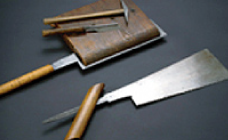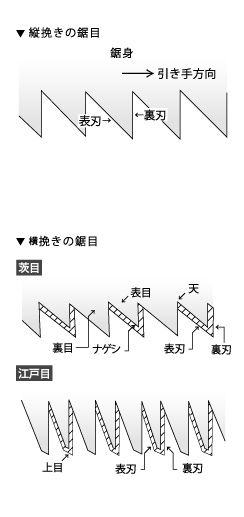Saw [nokogiri]
Saw
Saw

The vertical saw (tooth mold) is as shown in the figure on the left, and it is made to scrape wood fibers at the tip of the tooth. The jagged groove plays a role in carrying out the sawdust. The angle of the back blade and the upper blade (cut blade angle) and the angle of the tip wire and the back blade (cut angle) vary depending on the hardness of the cutting material. In the case of soft materials, both the cutting blade and the cutting angle are sharp angles, and in the case of hard materials, the angle is dull angles. The surface and back blades are generally finished so that they are right angles to the saw blade. Each tooth is designed to prevent the tip from being sandwiched between the left and right (clams / oscillation) from being sandwiched in the material.
As shown in the figure on the left, the front of the upper and back blades is sharp cut (nageshi), and the fiber of the wood is cut like a sword. Each tooth is lined up alternately on the left and right sides. Also, add clams like vertical saws. There are several types of saws. In contrast to the simple Ibarame, Edome is a grated tip with a file, as shown in the figure, and has a upper eye.

Basic information
Special Exhibition
Permanent exhibition